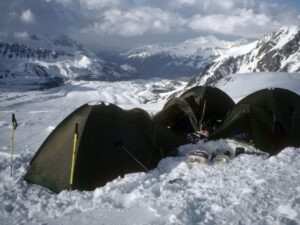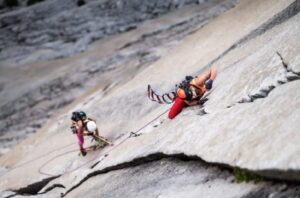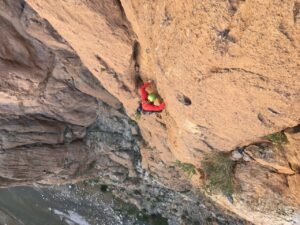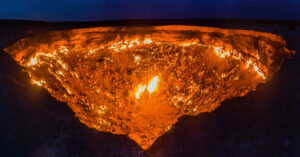Spanning over 5,600km, from the shores of the Red Sea to Mauritania on the Atlantic coast, the Sahara is the size of the United States. It covers almost one-third of Africa. The world’s largest non-polar desert includes 11 countries, with Morocco, Algeria, Tunisia, Libya and Egypt fronting the Mediterranean. To the south lie Niger, Chad, Mali and Sudan, which overlook the Sahel’s semi-arid grasslands and savannah.
A short history of the Sahara
Since the Book of Exodus in the sixth century BCE, which contains the earliest known accounts of desert travel, deserts have been frequently depicted as a soul-destroying sea of dunes, scorched earth and hellish nothingness. While large swathes of the Sahara are inhospitable –- there’s roughly one person per four square kilometres –- sand covers only 15 to 25 percent. The rest is gravelly plains, mountains, depressions and salt flats. It has 20 or so seasonal lakes and 90-plus oases. Its highest point is Mount Koussi (3,415m) in Chad and its lowest point is Egypt’s Qattara Depression (-133m). The 4,000 to 6,600km long Niger and Nile Rivers are its only permanent waterways.
Around 12,000 years ago, the Nile Valley, at the Sahara’s eastern edge, was its only habitable corner. A millennium-and-a-half later, unprecedented monsoon rains began to green much of the landscape into a savannah. The process took just a few hundred years. Unsurprisingly, inhabitants of the Nile –- which was now increasingly overcrowded –- began venturing west into the interior. They built prehistoric settlements beside lakes and survived through fishing and hunting hippopotamus, elephant, giraffe, crocodile and whatever else they could spear with their bone harpoons. This continued for a couple of thousand years, with an increasing number of groups converting to a nomadic pastoral lifestyle, supported by cattle, sheep and goats, and the cultivation of barley and wheat.

A map by cartographer Carl Churchill showing a speculative reconstruction of the Sahara’s lakes, rivers and grasslands between seventh to fourth millennium BCE.
Gradually, isolated communities developed specialized technologies. Copper Age Egyptians shaped blades from Ethiopian-imported obsidian, Bronze Age Mauritanians extracted copper and Iron Age Nigerians mined salt in the dunes of northeast Niger. In turn, this created economic interdependence and gave rise to a complex network of trans-Saharan trade routes.
A Google Map created by Amado Alfadni, Pau Cata, Eleonora Castagnone, and Carlos Perez Marin outlining the Sahara’s trade networks, as seen via their Project Qafila page. They compiled the route data from five Sahara books: Eric Rosse’s The Trans-Saharan Book Trade, Frédéric Nussy’s Caravanes d’Alger au Niger par le Hoggar, W.B.K. Shaw’s The Forty Day Road, Ahmed Abdel Ghaffar’s Sudanese Trade in Black Ivory, and D Jacques-Meunié’s Les Maroc Saharien des Origines à 1670. Marin has undertaken several 250 to 400km camel-supported journeys in Morocco, retracing sections of old caravan routes.
Security in the Sahara
Many of the trade routes are still in use today, though cars and trucks traveling unpaved roads have largely replaced camels. Two exceptions are the Azalai and Taghlamt salt caravan routes, run by Tuareg traders. Each stretches 600km between Mali’s Timbuktu and the Taoudenni salt mine. A slightly shorter one links Niger’s Agadez and the Bilma salt mine.
As romantic as travel here may seem, many of these ancient routes and regions of the Sahara are overshadowed by security issues, linked to illicit trafficking and trade, inter-ethnic conflict, separatism and terror organizations — much of it interconnected.
Thus, it’s easy for government advisories to convince would-be travelers that the Sahara is off-limits or too dangerous to visit. Since 2003, 150 foreigners have been kidnapped for ransom in the region, including Christian missionaries, overland motorcyclists, 4x4ers, cyclists and NGO workers. In most cases, visitors were taken by Al Qaeda or ISIS-affiliated groups and held in northern Mali, Nigeria and Burkina Faso. Roughly 90 percent of these victims are either still in captivity or released. The remainder were killed or died from other causes.
While tragic, this figure is minuscule compared to the more than 6,600 African migrants estimated to have died trying to cross the Sahara via human trafficking.
Sahara exploration and adventure
Morocco is usually safe, but otherwise, knowing where to go is not easy and can include real risks. Information may be sketchy. Some areas are off-limits due to local regulations and conflict. But one Sahara aficionado has been helping others make sense of the desert’s ever-changing logistics and security: Chris Scott of Sahara-Overland.com. He publishes up-to-date information both online and via his numerous Sahara guides and instructional handbooks for vehicle expeditions.
“I came in toward the end of a brief Golden Age of independent desert tourism and travel [in the late 1970s and 80s],” Scott told ExWeb. “Since the turn of this century, and certainly since the Arab Spring, much of the Sahara has slowly reverted to a no-go zone for outsiders. This is mainly due to the activities of militias, Islamists and bandit gangs, or restrictions accessing areas where such groups, or less dangerous smugglers, are thought to operate.”
Scott adds: “Like any extreme and iconic environment, the Sahara attracts its share of determined thrill-seekers. The lateral “east-west” has long been a favorite route. Some have pushed Chinese wind-barrows, sailed sand yachts or run the width of the Sahara.”
Early in the twentieth century, Ahmed Hassanein Bey traveled 3,000km by camel from the Mediterranean to British Sudan and discovered the Jebel Uweinat massif. A few years later, Prince Kemal el Din visited and named the nearby Gilf Kebir plateau, using novel Citroën Kegresse half-track cars to cross the sands. Samir Lama, a former Egyptian matinee idol turned desert explorer, traveled with the French desert sage, Theodore Monod, in the 1970s and 1980s.
An excerpt – starting at 5.00 – showing historical footage of a 1924 and ’31 attempt to cross Africa, via the Sahara, with a fleet of Citroën Kegresse.
Canadian filmmaker Frank Cole undertook one of the most audacious modern journeys, traversing 7,300km alone from Mauritania to Sudan with two camels in 1990. Cole’s motivations for the trip are intriguing: He was a recluse fascinated by mortality, yet was so terrified of death that he undertook the crossing as a way to confront his fears.
It took him 11 months to reach the Red Sea. He documented the trip using a 16mm spring-wound camera and spent the next decade editing a film about the journey titled, Life Without Death. In 2000, shortly after the initial release of the film, Cole set off again to attempt a double-crossing of the Sahara but was bludgeoned to death by bandits on the eastern outskirts of Timbuktu, Mali. His body was found tied to a tree with his camels, footage and belongings gone.
Where to travel in the Sahara
In modern times, just about everywhere in the Sahara has been accessible at one time or another, even if it was just for a few years and only to the very intrepid. Some overlooked places fall between the historic north-south trade routes. The Libyan Desert in southwest Egypt (Gilf Kebir and Uweinat) is fascinating, says Scott; eastern Mauritania’s El Djouf less so. The far north and east of Niger have rarely been visited, even in the good years, because of its remoteness, the presence of Tubu militias and not insignificantly, land mines in key passes.
Modern desert dwellers typically make a living by guiding caravans or tourists, or else they pursue less legitimate activities. These desert nomads are puzzled by our attraction to the desert’s mystique, says Scott, but are more than happy to capitalize on it.
“Most prefer to follow well-worn “tramlines” and earn easy money, but one exception was a guy I knew in Algeria,” he says. “His lineage is Berabish (Arab) from Timbuktu, but dressing as a Tuareg was better for business. He ran a guiding agency but also had a reputation for sailing close to the wind with the authorities. He was up for my idea of crossing what I dubbed the Saharan “Empty Quarter” from Mauritania across northern Mali to Algeria, despite the risks. His fee was a nice red Landcruiser VX, which I managed to sell him on the side. Sure enough, his local connections, wily ways, and of course, language helped us out of some sticky situations.”

Left: Satellite photo of Waw-an-Namus (547m), a volcano in south-central Libya. Centre: Chris Scott’s 1998 photo of Waw-an-Namus. Right: A 12,000 km2 section of a 1950s French map of the Grand Erg de Bilma in northeast Niger, one of the lesser-explored regions of the Sahara. Photos: Chris Scott’s Sahara Blanks on the Map collection
Country by country
Providing detailed travel advice for 9.2 million km² is nearly impossible. As Scott says, “Things deteriorate quickly and improve slowly.” Nevertheless, the current snapshot, country by country, is:
Mauritania: Good security for at least 400km east, inland from the Atlantic Coast. Provinces near the Mali border, such as Adrar, Tagant, Hodh El Gharbi and Hodh Ech Chargui, may be less safe. A newly opened border has revived a colonial-era trans-Sahara route from Algeria across the Tiris Zemmour in the north, Scott points out. “I was heading for a recce here last spring before COVID closed the borders, but I hope to try this route next winter. In Mauritania, you have to search for the points of interest. There’s little to see in the far east, for example, other than say you’ve been there.”
Western Sahara: Travel and access along Moroccan-controlled Western Sahara (west of the Berm), running down the Atlantic Coast, is easy and safe. Expect a few military checkpoints. The main pistes are unpaved but marked, but be cautious about traveling inland away from them, because of the risk of mines.
Morocco: Straightforward access and safe. It’s easy to arrange independent camel-supported trips in the country.
Tunisia: Avoid the Libyan border zones and the far south, which is a military area. Certain spots near the Algerian border have experienced AQIM attacks. The Tunisian side of the sandy Grand Erg Oriental in the southwest is the only place to experience the Sahara.
Algeria: “In Algeria, only a relatively small region –- parts of the huge province of Illizi –- are open to off-highway travel,” says Scott. “It includes the fabulous ‘drive-in’ rock art of the Tadrart canyon, which is part of the Tassili N’Ajjer plateau.” The rest of the south is currently inaccessible off the highway, even if it’s safe enough. Algeria has yet to take Saudi’s step and ease restrictions on tourism, partly because of the perceived risk of over-border incursions to kidnap tourists.
Mali: A handful of travelers visit the country, but few, if any, travel overland over great distances. Open areas include Bamako, Siby in Manding Country, Djenne, Mopti, Sikasso, and Segou. Best to consult an experienced travel agency, such as the Mali-based Papillon Reizen. North of Timbuktu is off-limits: It’s the Sahara’s hotspot for trafficking and terror-related activity.
Niger: The Aïr Mountains and the Ténéré Desert, which stretches beyond Agadez and into western Chad, are worth visiting. Still, there are serious security issues in the area, and access is not guaranteed at the moment. If you are still interested, consult the local agency, Niger Travel and Tours.
Libya: North Africa’s most dangerous country. As with northern Mali, you can forget about visiting its deserts for a long time. It’s at war and there’s plenty of infighting between the national army, government and militia groups. While its capital, Tripoli, is not in the Sahara, it is sometimes possible to visit there with specialist adventure travel companies, such as Untamed Borders.
Chad: The mountains of northern Chad’s Borkou-Ennedi-Tibesti region (a.k.a. BET) is a highlight of the Sahara and open to visitors. Outside of the capital, N’Djamena, escort guides are required, although they don’t offer any real security. Overall, the country is relatively safe, as long as you avoid Lake Chad: The surrounding forests are a Boko Haram hideout. Anyway, it’s unlikely that you would be able to access the lake, unless you are working for an NGO.
Sudan: Traveling east of the Nile is not much of an issue. But the further west you go from the Nile (especially for the Darfur region), the more you require permits. The northwestern corner around the Libyan, Chad and Egyptian borders has a Norway-sized chunk of the desert that is mostly uninhabited, but its accessibility is unknown.
Egypt: Its western deserts are a highlight, particularly the Gilf region, which covers Jebel Uweinat to the south and the Great Sand Sea to the north. Although, obtaining permission with escorts to visit the Gilf region is highly unlikely and even in previous years it involved diving through “a series of flaming hoops for several months and paying a lot of money to various entities,” says Scott. The White Desert and the Eastern Desert, as well as parts on the Sinai, remain accessible.
His parting words of wisdom for any would-be desert explorer: “[Go with a] GPS, maps, sat phone and a sound plan, which will almost certainly not pan out as expected. Risks are much less if you don’t travel alone. Fuel is distance; water is time; carry more than you need of both.”
Finally, if a place is inaccessible, have patience. As the Arabs say, “everything passes.”







